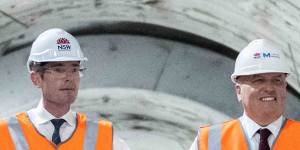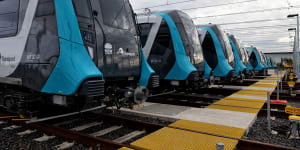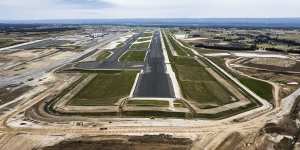With its station entrances rising like tentacles from the depths of the earth,the rail line is becoming more apparent to commuters. A at Central Station,built to accommodate new train platforms for the metro rail line under Sydney Harbour and the CBD,will open to commuters within months.

Premier Dominic Perrottet and Transport Minister David Elliott tour the City and Southwest tunnels in February.James Gourley
The City and Southwest line and the two other rail projects – a line from the,and a in western Sydney – form the country’s biggest public transport investment. They dwarf other rail lines built in Sydney in the last five decades such as the Eastern Suburbs line,the Airport Link and the South West Rail Link.
Yet as they reach critical stages of their development,the metro rail projects are running into massive challenges,exacerbated by supply chain bottlenecks,surging building costs and Australia’s east coast states competing against each other for contractors as they rush to live up to promises to build major infrastructure.
A trove of confidential documents released to the NSW parliament,as well as others leaked to theHerald,detail the enormous risks and costs faced by Sydney Metro,the agency overseeing the projects,and the contractors building the new lines.
A “sensitive” strategic risk assessment in September last year warned of “high” and “very high” risks across almost all of Sydney Metro’s measures.
And in further signs of the mounting stresses,a Sydney Metro risk assessment dated April this year warns of “over 350 very high and high risks driven by project cost impacts”.
It culminated in the government conceding two months ago that the cost of building the City and Southwest rail line will – the equivalent of building two lines. “They have got massive sticker shock ... and are under huge strain,” says an industry insider,who requested anonymity.

Les Wielinga,the head of the state’s transport bureaucracy between 2009 and 2013,fears the cost blowouts stem from insufficient preparatory work,investigations and risk contingencies in the early stages of the projects. “The first thing you have to do is properly investigate what you are going to build before you try to put a price on it. If you don’t do a proper investigation,you won’t get to the nub of all the problems,” he says.
“Bigger scope also creeps into these projects. As they start to add another car park or station,the costs start to get out of control.”
Wielinga was involved heavily in early work on what became known as,a rail line which opened in 2019 between Rouse Hill and Chatswood. It was the first stage of Sydney’s emerging metro rail network,and opened $1 billion under the original budget.
While shocked at the size of the blowout in the City and Southwest project,he is a supporter of the metro rail lines because of the sheer number of people they will be able to move – 40,000 an hour compared with about 24,000 an hour for the existing double-deck railway line.
Double-deck trains have to spend longer at stations to let passengers on and off. Apart from shorter dwell times at platforms,automated metro trains can operate at closer distances to each other,increasing their passenger capacity. “It’s about moving a large number of people in a peak period. That is the beauty of metro systems,” Wielinga says.
With the City and Southwest line,and the new metro line to Western Sydney Airport due to be opened progressively over the next four years,the projects are reaching the critical stage of their development and showing signs of the same problems that have plagued the construction of new railways overseas.

Driverless trains for the yet-to-open City and Southwest Metro rail line are stored near Rouse Hill in Sydney’s north-west.Nick Moir
Dubbed Crossrail during its construction,and later renamed the Elizabeth line, has been repeatedly delayed and overshot its budget by billions of pounds.
The City and Southwest project shares the most similar characteristics of Sydney’s metro lines to the London rail project. Like Crossrail,the $18.5 billion City and Southwest line runs under the CBD and requires a greater integration into the existing railway system,which raises significantly its complexity.
The conversion of a section of the century-old Bankstown line into one along which driverless trains will run every few minutes has also become one of the biggest technical headaches for the project. It has been compounded lately by preventing power being cut to high voltage lines in areas where work was due to occur.
Former top NSW rail executive Dick Day says it has become a “fairly normal phenomenon” for rail projects around the world to blow their budgets. “People in the planning stages underestimate the cost of building these projects and their complexity,” he says.
He describes the spending on construction of Sydney’s metro lines as mind-boggling,and worries that the benefits of them will be underwhelming given their cost. “The bidding war to get limited capabilities means we are inviting a very expensive feast. I would be less worried if the metro rail lines were desperately needed,” he says.
Day was one of four former NSW rail executives to that the City and Southwest line would lead to “degradation of the robustness and reliability” of Sydney’s existing heavy rail network. They feared that a “takeover” of the existing rail line between Sydenham and Bankstown for the metro trains would remove “the relief valve for the network”.

A new metro rail line will connect St Marys to Western Sydney Airport,which is under construction at Badgerys Creek.Brook Mitchell
Sydney Metro chief executive Peter Regan says the addition of more stations along the City and Southwest line at places such as Barangaroo and Waterloo,as well as rises in construction costs between 2014 and 2019,were part of the reason why the project’s budget was increased three years ago.
Under the original plans,the line was also to be above ground between Chatswood and St Leonards,but was later altered to run through tunnels along that section. A further increase in the project’s budget recently reflects major disruption from the pandemic over the last two years.
“It wasn’t just that you couldn’t get people from overseas – you couldn’t even get people to come in from Melbourne. The level of disruption that COVID caused was right at peak construction in the project. All that compounded because the project is such an integrated series of contracts,” Regan says.
“It’s like turning on the power. All the stations have to be ready. So if one got delayed,all the others got delayed by the same amount of time and then all the contracts that came behind it got delayed.”
With costs escalating,the government several large infrastructure projects several months ago,including a new motorway to Sydney’s northern beaches. An Infrastructure NSW report in late May,which was used to justify the government’s decision,recommended the state’s focus on mega projects give way to a combination of smaller and medium-sized programs such as station upgrades and fixing road pinch points.
Grattan Institute’s transport and cities program director,Marion Terrill,doubts there will be a reprieve from escalating costs for the rail projects for years,partly due to the scale of the infrastructure under construction or planned on the east coast. “NSW has slowed down some of their projects,but I don’t see any sign that is happening in Victoria and Queensland,and they are to some degree competing for the same resources,” she says.
Of the three projects,the 23-kilometre metro line to Western Sydney Airport,much of which involves tunnelling under paddocks,has been in the firing line the most. The country’s peak infrastructure adviser warned last year that the project’s cost by $1.8 billion.
Terrill says the jury is still out on whether the pandemic will have a long-lasting influence on the way people work and travel,and whether the full benefits of the mega rail projects will be realised.
“Rail projects are more in the ‘questionable’ parcel because they are not very flexible. If you lay a rail line,you have it for 100 years,” she says. “There is no doubt that the scale of investment[in Sydney] is transformative,but it is clear that what is partly at stake is what we forgo by choosing this path.”
Regan says the pandemic has resulted in patronage on Sydney’s railways becoming spread more throughout the day,compared with it previously being clustered in the morning and afternoon peaks. “Because most of our[metro] stations are centred in activated precincts where you’ve got people coming and going for different purposes,we’re expecting ... that you’ll still have very strong patronage right through the day,” he says.
“The broader benefits[of the metro lines] are still there. Different trips continue to be a big part of the benefit that it drives.”
The Perrottet government has much riding on the metro rail lines. During the last election campaign in 2019,then premier Gladys Berejiklian used the projects repeatedly to support her proposition that the Coalition delivered on its promises to build much-needed transport infrastructure.
With the state election in less than eight months,a government mired in a over the appointment of former deputy premier John Barilaro to a top trade role in New York can ill afford its flagship rail projects running into more costly problems.
The Morning Edition newsletter is our guide to the day’s most important and interesting stories,analysis and insights..